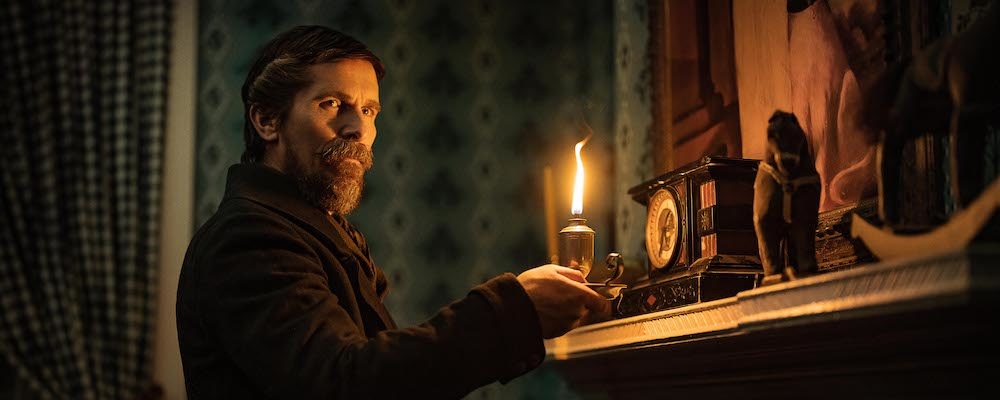‘The Pale Blue Eye’: Edgar Allan Poe Is on the Case in Melancholic Thriller
Alci Rengifo
If only a film like “The Pale Blue Eye” could survive on atmosphere alone. Here is another rich evocation of the 19th century from director Scott Cooper, who has a gifted eye for making you feel as if you have left our current timeline. The plot is based on a novel by Louis Bayard that plays around with one of those fun what ifs. Imagine if the great American writer Edgar Allan Poe had taken part in a gruesome murder mystery, where his gift for dark verse came in handy when figuring out the suspect. It’s a classic case of wishing our heroes were as we would like to imagine them. Poe is indeed the most entertaining aspect of this movie, played with melancholic, maddened eyes by Harry Melling. He’s well paired with Christian Bale, who plays another one of those rough, haunted men Cooper likes to feature.
It’s the 1830s at the West Point Military Academy. A retired detective, Augustus Landor (Bale), is called in to look into the gruesome death of a cadet named Fry, who is found hanging with his heart removed. Landor is a solitary type whose daughter left for mysterious reasons. His only companionship is a local tavern owner. But the military superiors of the institution hope he can crack the case, especially when another body turns up. Then Poe, who is a cadet at the school, appears and gives his theory. He is certain the killer must be a poet. As the two continue to delve into potential suspects, they also get close to the academy’s doctor, Daniel Marquis (Toby Jones) and his wife, Julia (Gillian Anderson). Before long, Poe is in love with the doctor’s daughter, Lea (Lucy Boynton).
In terms of texture, “The Pale Blue Eye” is impressive in the look achieved by cinematographer Masanobu Takayanagi, who makes West Point look like an eerie, snow-covered outpost where the woods hide secret terrors. Interiors are gothic and rugged. There’s little doubt this is probably the kind of world where Poe began to compose his first poems. You almost wish Cooper would have made a biopic. Missing here is the intensity of his 2017 “Hostiles,” also starring Bale as a melancholic, despairing lead, but in the form of a soldier transporting a Native American chief home amid the violence of the frontier wars. That movie also had a more clear sense of its themes and ideas. The eloquent cinematography and fierce violence evoked potent images about the roots of the United States. “The Pale Blue Eye” features Cooper’s love for slow burner images and editing, but feels like fascinating set ups that never fully deliver.
Soon enough the mystery gets lost behind the more intriguing characters. Augustus is himself a puzzle that won’t unspool until the very last moments of the movie, which are actually its most lucid. Poe is well-written as a wordsmith intoxicated by language, while seeming bookish and frail, while hiding a tougher interior. His courting of Lea can verge on dime novel romance, but has charming moments. Gillian Anderson, who has been on a winning streak of good roles for a while now, is great as the manic Julia, who loses control over dinners where other members of the Marquis clan prove unbearable. West Point also features the usual crop of expected essentials for a mystery. Superintendent Thayer (Timothy Spall) and Captain Hitchcock (Simon McBurney) want quick answers and culprits. The bullish, jock cadets like Randolph Ballinger (Fred Hechinger) inspire plenty of suspicion. Eventually in any mystery involving Edgar Allan Poe someone has to start finding satanic books and codes that hint at an occult explanation for the killings.
With more energy and sleuth attitude, “The Pale Blue Eye” could have amounted to much more. Cooper gets too taken in by the notion of trying to elevate the material to arthouse status, so by the middle it begins to drag. The sense of urgency gets lost and we’re not sure how any of the clues are connecting. The saving grace of the movie are the excellent performances and how Cooper attempts to connect poetry and prose to the art of profiling. Writing entails inhabiting other mindsets and creating characters. When the film becomes absorbing is when it plays with this idea of the poet outdoing the lawmen in imagining the motivations of the killer. And while the ending’s grand resolution seems to come out of nowhere, it is genuinely heartbreaking. “The Pale Blue Eye” closes as a mystery made up of intriguing, alluring parts that don’t always come together fully, but on their own demonstrate the skill of everyone involved. It’s nice to have a thriller reference Lord Byron. Cooper just needed to add more genuine suspense. Overall as a gothic experience it’s more about the ambiance than the payoff.
“The Pale Blue Eye” begins streaming Jan. 6 on Netflix.

